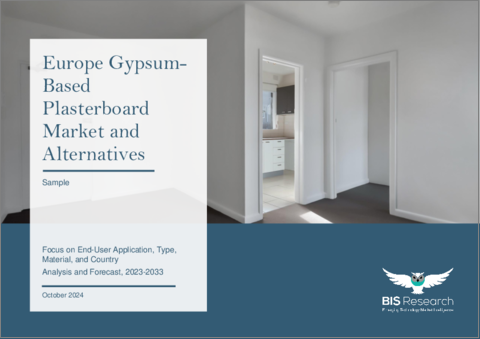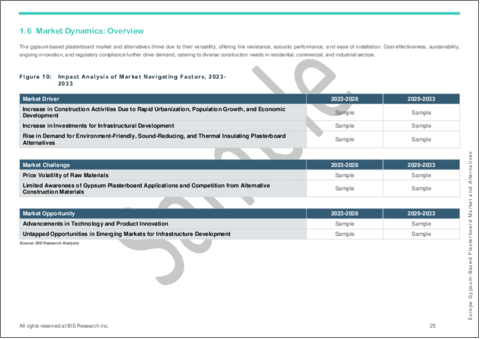|
|
市場調査レポート
商品コード
1578772
欧州の石膏ボードおよび代替品市場:エンドユーザー用途別、タイプ別、材料別、国別 - 分析と予測(2023年~2033年)Europe Gypsum-Based Plasterboard Market and Alternatives: Focus on End-User Application, Type, Material, and Country - Analysis and Forecast, 2023-2033 |
||||||
カスタマイズ可能
|
|||||||
| 欧州の石膏ボードおよび代替品市場:エンドユーザー用途別、タイプ別、材料別、国別 - 分析と予測(2023年~2033年) |
|
出版日: 2024年10月29日
発行: BIS Research
ページ情報: 英文 74 Pages
納期: 1~5営業日
|
全表示
- 概要
- 図表
- 目次
欧州の石膏ボードおよび代替品の市場規模は、2023年に71億米ドルとなりました。
同市場は、7.09%のCAGRで拡大し、2033年には140億8,000万米ドルに達すると予測されています。石膏ボードおよび代替品は、従来の化学物質投入に比べ多くの利点があるため、建築工法に革命を起こす態勢を整えています。この市場は現在成長段階にあり、大幅な拡大が見込まれています。パートナーシップ、インフラストラクチャー、研究への投資を行う企業は、こうした最先端のソリューションに対するニーズの高まりから利益を得る立場にあります。
| 主要市場統計 | |
|---|---|
| 予測期間 | 2023年~2033年 |
| 2023年の評価 | 71億米ドル |
| 2033年の予測 | 140億8,000万米ドル |
| CAGR | 7.09% |
欧州における石膏ボードおよび代替品市場は、手頃な価格で軽量かつ環境に優しい建築資材に対する消費者の需要の高まりにより、着実に拡大しています。石膏ボードは、施工が容易で耐火性、防音性に優れ、リサイクル可能であるため、現代の建築プロジェクトでは人気の高い選択肢となっています。住宅建築にも商業建築にも頻繁に使用されています。
石膏ボードおよび代替品は、欧州ではエネルギー効率と持続可能性を優先する傾向が続いており、従来の材料に比べて環境への悪影響が少ないことから、人気が高まっています。製造技術の向上も、これらの商品の堅牢性と適応性を高めることで市場に利益をもたらしています。石膏系製品の人気は、環境に優しい建築技術や持続可能な資源の使用を支援する規制の枠組みによっても後押しされています。
リサイクル材料や最先端の複合材料など、性能の向上と環境面での利点を提供する代替材料は、強力なライバルになりつつあります。研究開発、インフラ整備、戦略的提携を優先する市場参入企業が、この新興国市場の拡大傾向を利用し、今後数年間で新たな市場機会を開拓することが予想されます。石膏ベースのプラスターボードとその代替品の市場は、欧州全域で建築活動が活発化するにつれて大きく発展すると予想されます。
当レポートでは、欧州の石膏ボードおよび代替品市場について調査し、市場の概要とともに、エンドユーザー用途別、タイプ別、材料別、国別の動向、および市場に参入する企業のプロファイルなどを提供しています。
目次
エグゼクティブサマリー
第1章 市場
- 建設業界の動向:現状と将来
- サプライチェーンの概要
- 研究開発レビュー
- 規制状況
- ステークホルダー分析
- 市場力学:概要
- スタートアップと投資の概要
- 代替品の生産技術
- 石膏ボードと代替品の比較分析
第2章 地域
- 石膏ボードおよび代替品(地域別)
- 欧州
第3章 企業プロファイル
第4章 調査手法
List of Figures
- Figure 1: Europe Gypsum-Based Plasterboard Market and Alternatives, $Billion, 2022, 2026, and 2033
- Figure 2: Europe Gypsum-Based Plasterboard Market and Alternatives (by End-User Application), $Million, 2022, 2026, and 2033
- Figure 3: Europe Gypsum-Based Plasterboard Market and Alternatives (by Type), $Million, 2022, 2026, and 2033
- Figure 4: Europe Gypsum-Based Plasterboard Market and Alternatives (by Material), $Million, 2022, 2026, and 2033
- Figure 5: Key Events
- Figure 6: Supply Chain and Risks within the Supply Chain
- Figure 7: Value Chain Analysis
- Figure 8: Patent Analysis (by Country), January 2020-December 2023
- Figure 9: Patent Analysis (by Company), January 2020-December 2023
- Figure 10: Impact Analysis of Market Navigating Factors, 2023-2033
- Figure 11: Number of People Living in Urban and Rural Areas, Billion, 2018-2021
- Figure 12: Share of Construction in GDP, Europe, Percentage, 2022
- Figure 13: Germany Gypsum-Based Plasterboard Market and Alternatives, $Million, 2022-2033
- Figure 14: France Gypsum-Based Plasterboard Market and Alternatives, $Million, 2022-2033
- Figure 15: U.K. Gypsum-Based Plasterboard Market and Alternatives, $Million, 2022-2033
- Figure 16: Italy Gypsum-Based Plasterboard Market and Alternatives, $Million, 2022-2033
- Figure 17: Rest-of-Europe Gypsum-Based Plasterboard Market and Alternatives, $Million, 2022-2033
- Figure 18: Data Triangulation
- Figure 19: Top-Down and Bottom-Up Approach
- Figure 20: Assumptions and Limitations
List of Tables
- Table 1: Market Snapshot
- Table 2: Opportunities across Region
- Table 3: Competitive Landscape Snapshot
- Table 4: Trends: Overview
- Table 5: Projects on Sustainable Construction
- Table 6: Use Cases and Applications in the Construction Industry
- Table 7: Pricing Analysis (by Type), $/Meter Square, 2022-2033
- Table 8: Key Patent Mapping
- Table 9: Regulatory Landscape
- Table 10: Stakeholder Analysis
- Table 11: Use Cases and Applications in the Construction Industry
- Table 12: Startup and Investment Landscape
- Table 13: Comparative Analysis of Gypsum-based Plasterboard and Alternatives
- Table 14: Gypsum-Based Plasterboard Market and Alternatives (by Region), $Million, 2022-2033
- Table 15: Europe Gypsum-Based Plasterboard Market and Alternatives (by End-User Application), $Million, 2022-2033
- Table 16: Europe Gypsum-Based Plasterboard Market and Alternatives (by Type), $Million, 2022-2033
- Table 17: Europe Gypsum-Based Plasterboard Market and Alternatives (by Material), $Million, 2022-2033
- Table 18: Germany Gypsum-Based Plasterboard Market and Alternatives (by End-User Application), $Million, 2022-2033
- Table 19: Germany Gypsum-Based Plasterboard Market and Alternatives (by Type), $Million, 2022-2033
- Table 20: Germany Gypsum-Based Plasterboard Market and Alternatives (by Material), $Million, 2022-2033
- Table 21: France Gypsum-Based Plasterboard Market and Alternatives (by End-User Application), $Million, 2022-2033
- Table 22: France Gypsum-Based Plasterboard Market and Alternatives (by Type), $Million, 2022-2033
- Table 23: France Gypsum-Based Plasterboard Market and Alternatives (by Material), $Million, 2022-2033
- Table 24: U.K. Gypsum-Based Plasterboard Market and Alternatives (by End-User Application), $Million, 2022-2033
- Table 25: U.K. Gypsum-Based Plasterboard Market and Alternatives (by Type), $Million, 2022-2033
- Table 26: U.K. Gypsum-Based Plasterboard Market and Alternatives (by Material), $Million, 2022-2033
- Table 27: Italy Gypsum-Based Plasterboard Market and Alternatives (by End-User Application), $Million, 2022-2033
- Table 28: Italy Gypsum-Based Plasterboard Market and Alternatives (by Type), $Million, 2022-2033
- Table 29: Italy Gypsum-Based Plasterboard Market and Alternatives (by Material), $Million, 2022-2033
- Table 30: Rest-of-Europe Gypsum-Based Plasterboard Market and Alternatives (by End-User Application), $Million, 2022-2033
- Table 31: Rest-of-Europe Gypsum-Based Plasterboard Market and Alternatives (by Type), $Million, 2022-2033
- Table 32: Rest-of-Europe Gypsum-Based Plasterboard Market and Alternatives (by Material), $Million, 2022-2033
Introduction to Europe Gypsum-Based Plasterboard Market and Alternatives
The Europe gypsum-based plasterboard market and alternatives was valued at $7.10 billion in 2023, and it is expected to grow at a CAGR of 7.09% and reach $14.08 billion by 2033. Gypsum-based plasterboard and its substitutes are poised to revolutionize building methods due to their many advantages over conventional chemical inputs. This market is now in a growth phase and is anticipated to increase significantly. Businesses that make investments in partnerships, infrastructure, and research stand to gain from the growing need for these cutting-edge solutions.
Market Introduction
| KEY MARKET STATISTICS | |
|---|---|
| Forecast Period | 2023 - 2033 |
| 2023 Evaluation | $7.10 Billion |
| 2033 Forecast | $14.08 Billion |
| CAGR | 7.09% |
The market for gypsum-based plasterboard and substitutes in Europe is expanding steadily due to rising consumer demand for affordable, lightweight, and environmentally friendly building supplies. Gypsum-based plasterboard is a popular option for contemporary building projects since it is easy to install, fire resistant, soundproof, and recyclable. It is frequently used in both residential and commercial construction.
Gypsum-based plasterboard and its substitutes are becoming more popular in Europe as the continent continues to prioritize energy efficiency and sustainability in building because of their less detrimental effects on the environment when compared to more conventional materials. Improvements in manufacturing techniques have also benefited the market by increasing the robustness and adaptability of these goods. The popularity of gypsum-based goods is also fueled by regulatory frameworks that support eco-friendly building techniques and the use of sustainable resources.
Alternative materials that offer improved performance and environmental advantages, such as those composed of recycled materials or cutting-edge composites, are becoming formidable rivals. It is anticipated that market participants who prioritize R&D, infrastructure development, and strategic alliances would take advantage of this expanding trend, opening up new market opportunities in the years to come. The market for gypsum-based plasterboard and substitutes is anticipated to develop significantly as building activity increases throughout Europe.
Market Segmentation
Segmentation 1: by End-User Application
- Residential
- Non-Residential
Segmentation 2: by Type
- Standard Plasterboard
- Fire-Resistant Plasterboard
- Sound-Insulated Plasterboard
- Thermal Plasterboard
- Moisture-Resistant Plasterboard
- Impact-Resistant Plasterboard
- Others
Segmentation 3: by Material
- Gypsum
- Bio-Based
Segmentation 4: by Region
- Europe: Germany, France, U.K., Italy, and Rest-of-Europe
How can this report add value to an organization?
Product/Innovation Strategy: The product segment helps the reader understand the different applications of gypsum-based plasterboard and alternatives available based on end-user application (residential and non-residential), type (standard plasterboard, fire-resistant plasterboard, sound-insulated plasterboard, thermal plasterboard, moisture-resistant plasterboard, impact-resistant plasterboard, and others) and material (gypsum and bio-based) market is poised for significant expansion with ongoing technological advancements, increased investments, and growing awareness of gypsum-based plasterboard and alternatives. Therefore, this business is a high-investment and high-revenue generating model.
Growth/Marketing Strategy: The Europe gypsum-based plasterboard market and alternatives has been growing at a rapid pace. The market offers enormous opportunities for existing and emerging market players. Some of the strategies covered in this segment are mergers and acquisitions, product launches, partnerships and collaborations, business expansions, and investments. The strategies preferred by companies to maintain and strengthen their market position primarily include product development and partnerships and collaborations.
Competitive Strategy: The key players in the Europe gypsum-based plasterboard market and alternatives analyzed and profiled in the study include gypsum-based plasterboard manufacturers. Additionally, a comprehensive competitive landscape such as partnerships, agreements, and collaborations are expected to aid the reader in understanding the untapped revenue pockets in the market.
Key Market Players and Competition Synopsis
The companies that are profiled in the Europe gypsum-based plasterboard market and alternatives have been selected based on inputs gathered from primary experts and analyzing company coverage, product portfolio, and market penetration.
Some of the prominent names in the market are:
- Saint-Gobain Group
- Knauf Digital GmbH
- Etex Group
- Hemspan
- Adaptavate Ltd
- Smarter Habitat GmbH & Co KG
Table of Contents
Executive Summary
Scope and Definition
1 Markets
- 1.1 Construction Industry Trends: Current and Future
- 1.1.1 Growing Emphasis on Sustainable Construction Practices
- 1.1.2 Adoption of Digitalization and Generative AI
- 1.2 Supply Chain Overview
- 1.2.1 Value Chain Analysis
- 1.2.2 Price Comparison
- 1.3 Research and Development Review
- 1.3.1 Patent Filing Trend (by Country, Company)
- 1.4 Regulatory Landscape
- 1.5 Stakeholder Analysis
- 1.6 Market Dynamics: Overview
- 1.6.1 Market Drivers
- 1.6.1.1 Increase in Construction Activities Due to Rapid Urbanization, Population Growth, and Economic Development
- 1.6.1.2 Increase in Investments for Infrastructural Development
- 1.6.1.3 Rise in Demand for Environment-Friendly, Sound-Reducing, and Thermal Insulating Plasterboard Alternatives
- 1.6.2 Market Challenges
- 1.6.2.1 Price Volatility of Raw Materials
- 1.6.2.2 Limited Awareness of Gypsum Plasterboard Applications and Competition from Alternative Construction Materials
- 1.6.3 Market Opportunities
- 1.6.3.1 Advancements in Technology and Product Innovation
- 1.6.3.2 Untapped Opportunities in Emerging Markets for Infrastructure Development
- 1.6.1 Market Drivers
- 1.7 Startup and Investment Summary
- 1.8 Production Technologies for Alternatives
- 1.9 Comparative Analysis of Gypsum-Based Plasterboard and Alternatives
2 Regions
- 2.1 Gypsum-Based Plasterboard Market and Alternatives (by Region)
- 2.2 Europe
- 2.2.1 Market
- 2.2.1.1 Key Market Participants in Europe
- 2.2.1.2 Business Drivers
- 2.2.1.3 Business Challenges
- 2.2.2 Application
- 2.2.3 Product
- 2.2.4 Europe (by Country)
- 2.2.4.1 Germany
- 2.2.4.2 France
- 2.2.4.3 U.K.
- 2.2.4.4 Italy
- 2.2.4.5 Rest-of-Europe
- 2.2.1 Market
3 Company Profile
- 3.1 Company Profiles
- 3.1.1 Saint-Gobain Group
- 3.1.1.1 Overview
- 3.1.1.2 Top Products/Product Portfolio
- 3.1.1.3 Top Competitors
- 3.1.1.4 Target Customers
- 3.1.1.5 Key Personnel
- 3.1.1.6 Analyst View
- 3.1.1.7 Market Share
- 3.1.2 Knauf Digital GmbH
- 3.1.2.1 Overview
- 3.1.2.2 Top Products/Product Portfolio
- 3.1.2.3 Top Competitors
- 3.1.2.4 Target Customers
- 3.1.2.5 Key Personnel
- 3.1.2.6 Analyst View
- 3.1.2.7 Market Share
- 3.1.3 Etex Group
- 3.1.3.1 Overview
- 3.1.3.2 Top Products/Product Portfolio
- 3.1.3.3 Top Competitors
- 3.1.3.4 Target Customers
- 3.1.3.5 Key Personnel
- 3.1.3.6 Analyst View
- 3.1.3.7 Market Share
- 3.1.4 Hemspan
- 3.1.4.1 Overview
- 3.1.4.2 Top Products/Product Portfolio
- 3.1.4.3 Top Competitors
- 3.1.4.4 Target Customers
- 3.1.4.5 Key Personnel
- 3.1.4.6 Analyst View
- 3.1.4.7 Market Share
- 3.1.5 Adaptavate Ltd
- 3.1.5.1 Overview
- 3.1.5.2 Top Products/Product Portfolio
- 3.1.5.3 Top Competitors
- 3.1.5.4 Target Customers
- 3.1.5.5 Key Personnel
- 3.1.5.6 Analyst View
- 3.1.5.7 Market Share
- 3.1.6 Smarter Habitat GmbH & Co KG
- 3.1.6.1 Overview
- 3.1.6.2 Top Products/Product Portfolio
- 3.1.6.3 Top Competitors
- 3.1.6.4 Target Customers
- 3.1.6.5 Key Personnel
- 3.1.6.6 Analyst View
- 3.1.6.7 Market Share
- 3.1.1 Saint-Gobain Group
4 Research Methodology
- 4.1 Data Sources
- 4.1.1 Primary Data Sources
- 4.1.2 Secondary Data Sources
- 4.1.3 Data Triangulation
- 4.2 Market Estimation and Forecast





